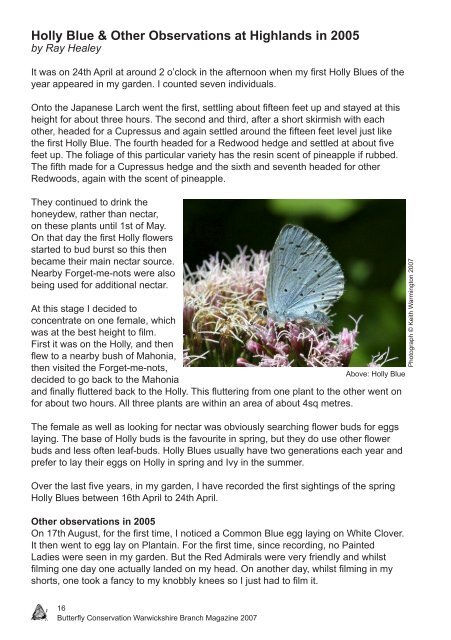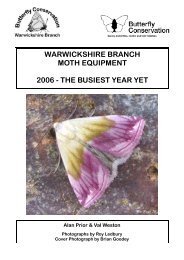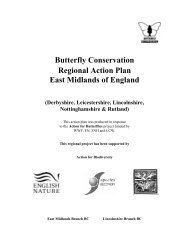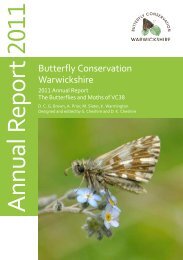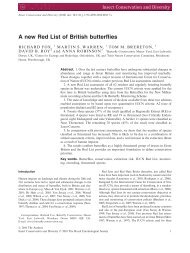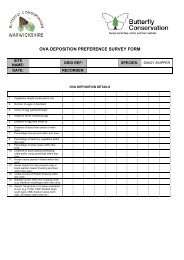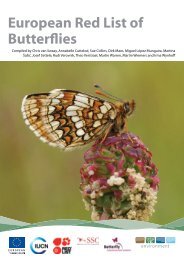2007 Magazine Version 05.indd - Butterfly Conservation Warwickshire
2007 Magazine Version 05.indd - Butterfly Conservation Warwickshire
2007 Magazine Version 05.indd - Butterfly Conservation Warwickshire
You also want an ePaper? Increase the reach of your titles
YUMPU automatically turns print PDFs into web optimized ePapers that Google loves.
Holly Blue & Other Observations at Highlands in 2005<br />
by Ray Healey<br />
It was on 24th April at around 2 o’clock in the afternoon when my first Holly Blues of the<br />
year appeared in my garden. I counted seven individuals.<br />
Onto the Japanese Larch went the first, settling about fifteen feet up and stayed at this<br />
height for about three hours. The second and third, after a short skirmish with each<br />
other, headed for a Cupressus and again settled around the fifteen feet level just like<br />
the first Holly Blue. The fourth headed for a Redwood hedge and settled at about five<br />
feet up. The foliage of this particular variety has the resin scent of pineapple if rubbed.<br />
The fifth made for a Cupressus hedge and the sixth and seventh headed for other<br />
Redwoods, again with the scent of pineapple.<br />
They continued to drink the<br />
honeydew, rather than nectar,<br />
on these plants until 1st of May.<br />
On that day the first Holly flowers<br />
started to bud burst so this then<br />
became their main nectar source.<br />
Nearby Forget-me-nots were also<br />
being used for additional nectar.<br />
At this stage I decided to<br />
concentrate on one female, which<br />
was at the best height to film.<br />
First it was on the Holly, and then<br />
flew to a nearby bush of Mahonia,<br />
then visited the Forget-me-nots,<br />
Above: Holly Blue<br />
decided to go back to the Mahonia<br />
and finally fluttered back to the Holly. This fluttering from one plant to the other went on<br />
for about two hours. All three plants are within an area of about 4sq metres.<br />
The female as well as looking for nectar was obviously searching flower buds for eggs<br />
laying. The base of Holly buds is the favourite in spring, but they do use other flower<br />
buds and less often leaf-buds. Holly Blues usually have two generations each year and<br />
prefer to lay their eggs on Holly in spring and Ivy in the summer.<br />
Over the last five years, in my garden, I have recorded the first sightings of the spring<br />
Holly Blues between 16th April to 24th April.<br />
Other observations in 2005<br />
On 17th August, for the first time, I noticed a Common Blue egg laying on White Clover.<br />
It then went to egg lay on Plantain. For the first time, since recording, no Painted<br />
Ladies were seen in my garden. But the Red Admirals were very friendly and whilst<br />
filming one day one actually landed on my head. On another day, whilst filming in my<br />
shorts, one took a fancy to my knobbly knees so I just had to film it.<br />
Photograph © Keith Warmington <strong>2007</strong><br />
16<br />
<strong>Butterfly</strong> <strong>Conservation</strong> <strong>Warwickshire</strong> Branch <strong>Magazine</strong> <strong>2007</strong>


